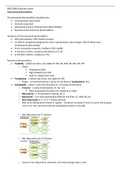BHCS3009 summary notes
Autosomal abnormalities
Chromosomal abnormalities classified into
• Constitutional (born with)
• Somatic (acquired)
• Autosomal and sex chromosomes abnormalities
• Numerical and structural abnormalities
Incidence of chromosomal abnormalities
• 10% spermatozoa, 25% mature oocytes
• 15-20% of recognised pregnancies end in spontaneous miscarriages, 50% of those have
chromosome abnormality
• From conception onwards, incidence falls rapidly
• In live born infants, incidence declined to 0.5-1%
• In still born infants, incidence is 5%
Numerical abnormalities
• Triploidy – whole set extra, not viable for life; 69, XXX, 69, XXY, 69, XYY
o Origin
▪ Polyspermy 66%
▪ Egg is diploid (2n) 10%
▪ Sperm is diploid (2n) 24%
• Tetraploidy – 2 whole sets extra, not viable for life
o Origin - normal fertilisation, failure of cell division (endomitosis, 4n)
• Aneuploidy – either 1 extra chromosome or 1 missing chromosome
o Trisomy – 1 extra chromosome; 47, XX, +21
▪ Most autosomal trisomies are maternal in origin
o Monosomy – 1 chromosome missing; 45, X
o Mosaicism – 2 or more genetically different cell lines; 47, XXX/ 46, XX
o Non-disjunction at 1st or 2nd meiotic division
o Also occur during early mitosis in zygote = mosaicism as doesn’t occur in every cell so gives
rise to 2 or mor cell lines (meiotic aneuploidy present in all cells)
o Non-disjunction at 1st division
o Non-disjunction at 2nd division
o Cause of non-disjunction unknown, but maternal age plays a role
, o Absence of recombination at meiosis I (in foetal ovary) and abnormalities in spindle
formation may be implicated
Structural abnormalities
• Deletion – 46, XY, del (4) (p16.3)
• Ring – 46, XY r (7) (p22q36)
• Duplication – 46, XX, dup (1) (q22p25)
• Insertion – 46, XY, ins (2) (p13, q21, q31)
• Inversion – 46, XY, inv (11) (p11p15)
• Translocation, reciprocal – 46, XX, t (2;6) (q36; p21.3)
• Marker – 47, XX, +mark (do not know origin of chromosome piece)
• Paracentric inversion
o Doesn’t involve centromere
o Meiotic products resulting from a single crossover within a
paracentric inversion loop
o Two non-sister chromatids crossover within a loop
o When homologous chromatids pair up, inverted chromatid
forms loop to match up correctly with its homologue
o This forms strange rearrangements when chromatids
segregate creating deletion and inversion products
o Acentric fragment formed (no centromere) and is lost from
nucleus
• Pericentric inversion
o Involved centromere (spans across centromere)
o Create products with deletions, duplications and inversion in both
arms of chromatids
• Translocations
o Reciprocal translocation
▪ Breakage in 2 chromosomes which recombine
▪ Exchange of centric and acentric fragments = Dicentric and acentric chromosomes
formed – not stable
▪ Exchange of two acentric fragments = forms 2 stable chromosomes
▪ Reciprocal translocation carrier
• Other modes of segregation at meiosis possible





